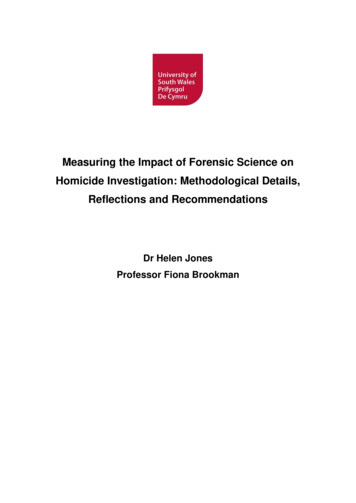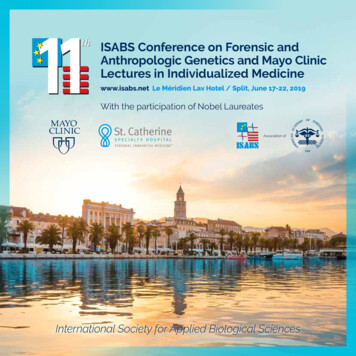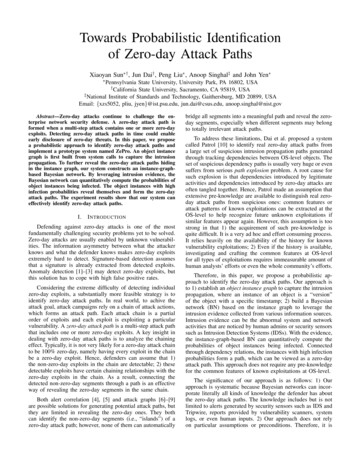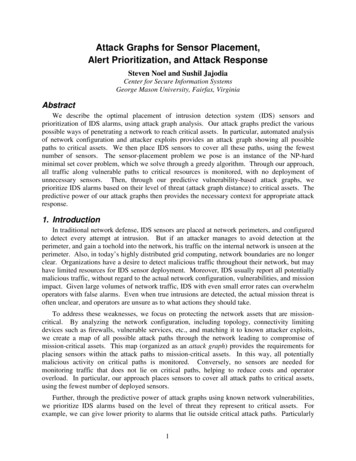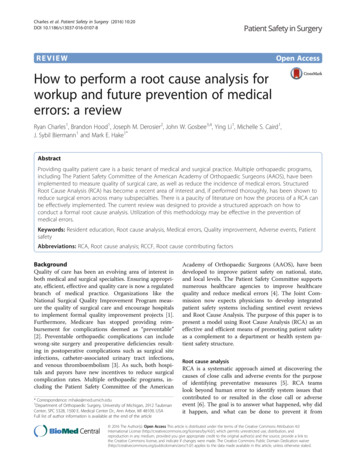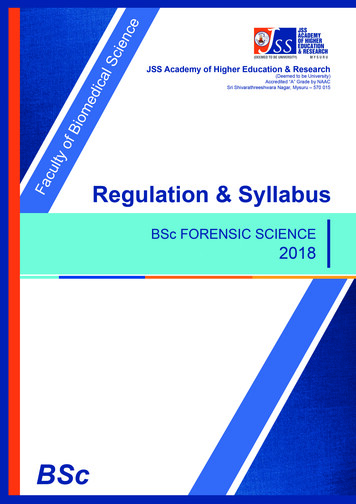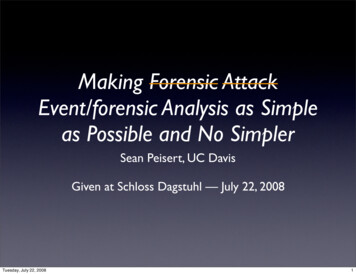
Transcription
Making Forensic AttackEvent/forensic Analysis as Simpleas Possible and No SimplerSean Peisert, UC DavisGiven at Schloss Dagstuhl — July 22, 2008Tuesday, July 22, 20081
Electronic Voting Machines Need to be able to count ballots Cannot allow an auditor to determine who a voter is (votercoersion) This leads to a direct conflict. So how do we balance this?Need to be able to determine if and how a machine failed.Cannot allow a voter to indicate to an auditor who they are(vote selling) Add noiseEnforce regularity2Tuesday, July 22, 20082
Existing Technical Solutions andthe Insider Problem Access Control Intrusion Detection Anomaly-Based Detection Misuse-Based Detection Signature-Based DetectionTuesday, July 22, 20083
Optimistic Access Control Tuesday, July 22, 2008Security and usability are in conflict.Ideally, a system should block all forbidden actions and permit allallowed actions. (This is not feasible.)Policies can be binary (block access) or flexible (perform thiscountermeasure).Policies can be static (always do this) or dynamic (uh oh—an intruder)Many possible countermeasures existlogcheckpoint/replaymake a particular partition read-onlyMany possible dynamic approaches existUse an a standard IPSIncorporate external factors 4
So we need to focus onnon-binary (e.g., postmortem analysis).Tuesday, July 22, 20085
What is forensic Analysis? forensic analysis is the process of answering the questions: How did an event take place?What was the nature of the event?What were the effects of the event?forensic analysis applies to arbitrary events. This can includeattacks, but is not limited to attacks (e.g., mistakes).forensic analysis is not intrusion detection. The goal of intrusion detection is to determine whether anattack occurred.6Tuesday, July 22, 20086
Transparent Society(abbreviated from David Brin’s ideas) Anyone can know anything. There is no privacy. It’s better if everyone knows everythingthan if a few people know everything. “Watching the watchers” R. Heinlein: “‘privacy laws’ only make thebugs smaller.”Tuesday, July 22, 20087
Audit trails are. Is it is not well understood what forensic data is necessary,and there is no general solution to find that data.Data is often redundant, missing, vague, or misleading.Forensic analysis is worthless with bad data.We’re wasting time, drawing bad conclusions, and makingbad decisions.We need better data.A systematic approach to forensic logging gives better dataand better analysis.8Tuesday, July 22, 20088
Current State Decent tools, but what problem do they solve? file & filesystem analysis (Coroner’s Toolkit,Sleuth Kit, EnCase, FTK)syslog, tcpwrappers, Windows event logsBSMprocess accounting logsIDS logspacket sniffing9Tuesday, July 22, 20089
Forensics What do we need? What are we missing?10Tuesday, July 22, 200810
What are the assumptions forusing current forensic tools? Often that there’s only one person whohad access to the machine. Often that the owner of the machine wasin complete control (as opposed tomalware). Probably a lot of other assumptions thatwe have no clue about.11Tuesday, July 22, 200811
For forensics, we need to. go back to the beginning. log the dataunderstand what the purpose of the analysis isunderstand what data can answer that purpose,with X% accuracy, and under a set of Yassumptionsgive tools and techniques to an analyst to analyzethat data12Tuesday, July 22, 200812
Art & Science But computer science can only answer part of it.Forensic analysis is an art, but there are scientific components.What are they? Determining what to logDetermining relevance of logged data what is relevant?what is not relevant?under what circumstances something might be relevant?Using the results to constrain and correlate data.This can be measured, systematized and automated.13Tuesday, July 22, 200813
Logging Two options: Log everything (e.g., all non-deterministicevents), and capture upon replay Log selectively Ad hocSystematic (e.g., based on security policies)14Tuesday, July 22, 200814
A Systematic Approachis Better Given system S, that records data D, whatintrusions ID can we understand with the datawe have? Given intrusions I’, what additional data DI’ dowe need to record to analyze those intrusions? Given an arbitrary system defined by certainspecifications, what information must be loggedto detect violations of those specifications?15Tuesday, July 22, 200815
Laocoön Laocoön: A Model of Forensic LoggingAttack graphs of goals.Goals can be attacker goals or defender goals (i.e., “securitypolicies”)Pre-conditions & post-conditions of events to accomplish goals.Method of translating those conditions into logging requirements.Logs are in a standardized and parseable format.Logged data can be at arbitrary levels of granularity.16Tuesday, July 22, 200816
Goals Tuesday, July 22, 2008Premise: compute resources are cheap, human time isexpensive.Understand the scope of the possible data, analyses,and conclusions.Be able to define (or place bounds on) whatnecessary information is present and what is missing.Assuming all potentially relevant information isrecorded (e.g., by extrospection of a virtual machine),be able to correlate and prune the informationnecessary for a human to analyze.17
Attack Graphs Intruder goals can beenumerated.start of attackintermediate steps(too many!)end goals of intruder.Vulnerabilities, attacks,and exploits cannot (orin many cases, we wouldpatch them, or theywould inhibit usability).abcdDefender goals can alsobe enumerated. They arecalled security polices.18Tuesday, July 22, 200818
Security Policies Legal policies (HIPAA, Sarbanes-Oxley) Formal policies (Bell-LaPadula, Chinese Wall) Actual metrics Severity (path length, time, difficulty) Attack Surface Metric Historically known vulnerabilities19Tuesday, July 22, 200819
Security Policies Security policies can be reverse-engineered orenforced, automatically. i.e., determine the current policy, and modify. Policies can be binary (block access) or flexible (logsomething). Policies can be static (always do this) or dynamic (uhoh—an intruder)Assumptions get in the way of security. What are they?20Tuesday, July 22, 200820
Applying Security Policies Applying Laocoön to security policies guideswhere to place instrumentation and what to log. The logged data needs to be correlated with aunique path identifier. Branches of a graph unrelated to the attack canbe automatically pruned. Avoid recording data where events can berecreated because they are deterministic.21Tuesday, July 22, 200821
Pruning Pathsstart of attackAintermediate stepsBend goals of intruderCstart of attackADintermediate stepsBend goals of intruderCD22Tuesday, July 22, 200822
Pruning PathsTuesday, July 22, 200823
Pruning PathsGraph 62Node 1Node 3Node 4Node 5Tuesday, July 22, 200824
Pruning PathsGraph 62Node 1ExploitNode 3Node 4Node 5Tuesday, July 22, 200825
Complex Attack Graphabcd26Tuesday, July 22, 200826
Summary Forensics, attack analysis, logging, and auditing are broken. We have developed methods for logging based on knownvulnerabilities. We have developed methods for integrating societalneeds (e.g., law) with forensic logging and auditingcapabilities.We have developed methods to correlate and constraindata that needs to be analyzed.27Tuesday, July 22, 200827
Thank you Questions? Sean Peisert peisert@cs.ucdavis.edu http://www.sdsc.edu/ peisert/Tuesday, July 22, 200828
Audit trails are. Is it is not well understood what forensic data is necessary, and there is no general solution to find that data. Data is often redundant, missing, vague, or misleading. Forensic analysis is worthless with bad data. We're wasting time, drawing bad conclusions, and making bad decisions. We need better data. A systematic approach to forensic logging .

